Sulfur isotope fractionation during the evolutionary adaptation of a sulfate-reducing bacterium
- PMID: 25662968
- PMCID: PMC4375314
- DOI: 10.1128/AEM.03476-14
Sulfur isotope fractionation during the evolutionary adaptation of a sulfate-reducing bacterium
Abstract
Dissimilatory sulfate reduction is a microbial catabolic pathway that preferentially processes less massive sulfur isotopes relative to their heavier counterparts. This sulfur isotope fractionation is recorded in ancient sedimentary rocks and generally is considered to reflect a phenotypic response to environmental variations rather than to evolutionary adaptation. Modern sulfate-reducing microorganisms isolated from similar environments can exhibit a wide range of sulfur isotope fractionations, suggesting that adaptive processes influence the sulfur isotope phenotype. To date, the relationship between evolutionary adaptation and isotopic phenotypes has not been explored. We addressed this by studying the covariation of fitness, sulfur isotope fractionation, and growth characteristics in Desulfovibrio vulgaris Hildenborough in a microbial evolution experiment. After 560 generations, the mean fitness of the evolved lineages relative to the starting isogenic population had increased by ∼ 17%. After 927 generations, the mean fitness relative to the initial ancestral population had increased by ∼ 20%. Growth rate in exponential phase increased during the course of the experiment, suggesting that this was a primary influence behind the fitness increases. Consistent changes were observed within different selection intervals between fractionation and fitness. Fitness changes were associated with changes in exponential growth rate but changes in fractionation were not. Instead, they appeared to be a response to changes in the parameters that govern growth rate: yield and cell-specific sulfate respiration rate. We hypothesize that cell-specific sulfate respiration rate, in particular, provides a bridge that allows physiological controls on fractionation to cross over to the adaptive realm.
Copyright © 2015, American Society for Microbiology. All Rights Reserved.
Figures
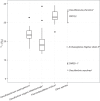

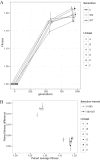
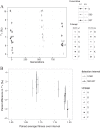
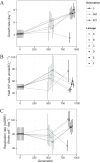
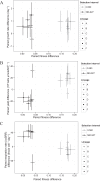

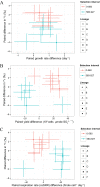
Similar articles
-
Patterns of sulfur isotope fractionation during microbial sulfate reduction.Geobiology. 2016 Jan;14(1):91-101. doi: 10.1111/gbi.12149. Epub 2015 Jul 20. Geobiology. 2016. PMID: 26189479
-
Sulfur Isotope Fractionation by Sulfate-Reducing Microbes Can Reflect Past Physiology.Environ Sci Technol. 2018 Apr 3;52(7):4013-4022. doi: 10.1021/acs.est.7b05119. Epub 2018 Mar 15. Environ Sci Technol. 2018. PMID: 29505248
-
Effects of Genetic and Physiological Divergence on the Evolution of a Sulfate-Reducing Bacterium under Conditions of Elevated Temperature.mBio. 2020 Aug 18;11(4):e00569-20. doi: 10.1128/mBio.00569-20. mBio. 2020. PMID: 32817099 Free PMC article.
-
Key Metabolites and Mechanistic Changes for Salt Tolerance in an Experimentally Evolved Sulfate-Reducing Bacterium, Desulfovibrio vulgaris.mBio. 2017 Nov 14;8(6):e01780-17. doi: 10.1128/mBio.01780-17. mBio. 2017. PMID: 29138306 Free PMC article.
-
What Controls the Sulfur Isotope Fractionation during Dissimilatory Sulfate Reduction?ACS Environ Au. 2023 Jan 3;3(2):76-86. doi: 10.1021/acsenvironau.2c00059. eCollection 2023 Mar 15. ACS Environ Au. 2023. PMID: 37102088 Free PMC article. Review.
Cited by
-
Stable isotopic signature of dissimilatory nitrate reduction is robust against enzyme mutation.Proc Natl Acad Sci U S A. 2024 Nov 26;121(48):e2416002121. doi: 10.1073/pnas.2416002121. Epub 2024 Nov 22. Proc Natl Acad Sci U S A. 2024. PMID: 39576351 Free PMC article.
-
The Biogeochemical Sulfur Cycle of Marine Sediments.Front Microbiol. 2019 Apr 24;10:849. doi: 10.3389/fmicb.2019.00849. eCollection 2019. Front Microbiol. 2019. PMID: 31105660 Free PMC article. Review.
-
Experimental Design, Population Dynamics, and Diversity in Microbial Experimental Evolution.Microbiol Mol Biol Rev. 2018 Jul 25;82(3):e00008-18. doi: 10.1128/MMBR.00008-18. Print 2018 Sep. Microbiol Mol Biol Rev. 2018. PMID: 30045954 Free PMC article. Review.
References
-
- Minz D, Fishbain S, Green SJ, Muyzer G, Cohen Y, Rittmann BE, Stahl DA. 1999. Unexpected population distribution in a microbial mat community: sulfate-reducing bacteria localized to the highly oxic chemocline in contrast to a eukaryotic preference for anoxia. Appl Environ Microbiol 65:4659–4665. - PMC - PubMed
Publication types
MeSH terms
Substances
LinkOut - more resources
Full Text Sources
Molecular Biology Databases

